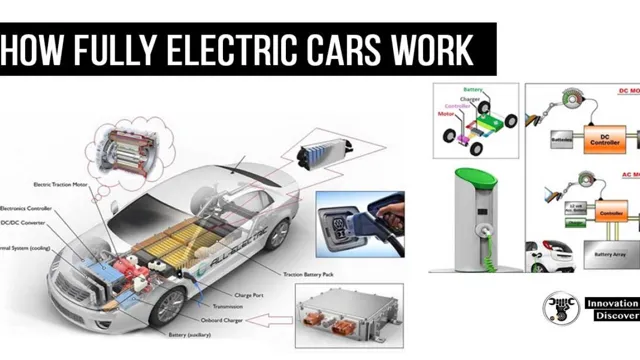Are you curious about how electric cars work? With the rise of eco-friendly vehicles, the electric car is becoming more and more popular. But what is the technology behind an electric car? From the batteries to the motors, this blog will explain the inner workings of electric cars and provide insight into why they are such a great choice for a greener future.
Understanding the Basics
Electric cars are becoming increasingly popular and are being seen on more and more roads. But how exactly do electric cars work? In this blog post, we will go over the basics of how an electric car works, and how it differs from traditional gasoline-powered vehicles. An electric car is powered by an electric motor that runs on electric energy stored in a battery.
This battery is recharged by plugging the car into an electric outlet or charging station. Unlike a gasoline-powered engine, an electric car does not require traditional fuel to power the engine. Instead, electricity flows from the battery to the motor, powering the car and allowing it to move.
Electric cars are generally more efficient than gasoline-powered vehicles, as they do not rely on the combustion of fossil fuels to move. This means that electric cars are more environmentally friendly, as they emit fewer greenhouse gases and other pollutants. Additionally, electric cars are typically quieter than traditional gasoline-powered vehicles, as the motor is powered by electricity rather than fuel.
The capacity of its battery determines the range of an electric car. The more powerful the battery, the further the car will be able to travel on a single charge. This range can vary depending on the model of the car, as well as additional factors such as terrain, driving style, and temperature.
Electric cars also offer a number of other advantages over traditional gasoline-powered vehicles. They are typically cheaper to maintain, as they do not require the same level of maintenance as gasoline-powered cars. Additionally, electric cars are often eligible for government incentives, as they are seen as an eco-friendly option.
Electric cars are becoming increasingly popular and are becoming more widely available. Understanding how they work can help you make an informed decision about whether or not an electric car is the right choice for you.
Components of an Electric Vehicle
Electric vehicles are becoming increasingly popular due to their numerous benefits, such as reduced emissions and lower running costs. But how exactly do they work? An electric vehicle consists of four major components that power the car: the battery, the motor, the controller, and the transmission. The battery stores electrical energy and provides power to the motor.
The motor then converts this electrical energy into mechanical energy, which is used to drive the wheels of the vehicle. The controller is responsible for controlling the amount of power delivered to the motor. Finally, the transmission is responsible for transferring power from the motor to the wheels.
Together, these four components are responsible for powering an electric vehicle and allowing it to move.

The Battery
The battery in an electric car is a complex and essential component, powering the vehicle and allowing it to travel long distances without requiring a recharge. In order to understand how an electric car works, it is important to understand exactly what a battery is and how it functions. A battery is an energy storage device, typically composed of several individual cells containing a chemical mixture that produces an electrical current when the cells are connected.
In an electric car, the battery is usually located under the floor of the vehicle and provides energy to the motor, which then propels the car forward. The battery is also responsible for powering any other electronic devices inside the car, such as the stereo, air conditioning, and lights. As the car travels, the battery slowly discharges its stored energy. It must be recharged at a charging station, typically located at a public charging facility or at the owner’s home.
Using an Electric Car
Electric cars are becoming more and more popular these days, but how do they actually work? Although the technology behind electric vehicles is complex, the basic principles are relatively simple to understand. An electric car is powered by an electric motor that is powered by a battery. The battery is usually made up of a large number of individual cells that are connected.
When the driver presses the accelerator pedal of the vehicle, electric current flows from the battery to the motor, causing it to rotate and propel the car forward. The energy from the battery is stored in chemical form and converted into electrical energy by the motor. This is done through a process called electromagnetism.
Inside the motor, a magnetic field is created by coils of copper wire. When the electric current flows through the coils, it creates a magnetic field that interacts with the permanent magnets inside the motor, causing it to rotate. This rotation is then transferred to the wheels of the car, which move the vehicle forward.
The battery of an electric car is typically recharged by plugging it into an external electrical outlet. This recharges the battery, allowing it to be used again. The energy stored in the battery is usually enough to power the vehicle for a few hours, depending on the type of battery and the amount of energy used.
In addition to the battery and motor, electric cars also have a few other components, such as a regenerative braking system and an electronic control unit. The regenerative braking system helps to capture some of the energy generated during braking and use it to recharge the battery. The electronic control unit is responsible for controlling the operation of the motor and battery, ensuring that the car runs efficiently and safely.
Overall, electric cars are becoming increasingly popular due to their efficient and environmentally friendly operation. By understanding the basic principles of how these vehicles work, you can make an informed decision when considering an electric car for yourself or your family.

Charging an EV
Charging an electric vehicle (EV) is an important part of owning one, but it’s important to understand how it works first. An EV has a battery that stores electricity, just like a smartphone or laptop. This battery powers the electric motor, which is what propels the car.
When the battery runs low, it needs to be recharged to continue running. This is done by plugging the car into a special charging station, which supplies electricity to the car. Depending on the type of station, the charging time can vary from a few hours to a few days.
To get the most out of your EV, it’s important to understand how it works so you can keep it charged and running smoothly.
Driving an EV
Electric vehicles (EVs) are becoming more and more popular as an eco-friendly alternative to traditional gas-powered cars. But how do they actually work? EVs are propelled by an electric motor powered by a battery pack that stores the electricity. The battery pack is recharged by plugging it into an external source of electricity.
When an EV is driven, the battery sends electricity to the motor, which makes it spin. This spinning motion is transferred to the axles and wheels, making the car move. The regenerative braking system captures some of the kinetic energy from the car’s brakes and converts it back into electricity to recharge the battery.
This helps to maximize the range of an electric car, meaning you can drive further on a single charge.
Pros and Cons of Owning an EV
Owning an electric vehicle (EV) can be an exciting prospect, but there are some important considerations to keep in mind. Understanding how an EV works and what it takes to maintain it is key to making the right decision. An electric car operates by converting stored energy from its battery into electrical energy, which is then used to power the car.
This means that you’ll be able to drive your car without relying on gasoline, resulting in fewer emissions and a quieter ride. While this is certainly an advantage, there are some drawbacks to consider, such as the higher initial cost of the car, the limited range of the car, and the need for regular maintenance and charging. However, with the right information and proper care, an EV can be a great addition to any household.

Advantages of electric cars:
- Zero emissions: Electric cars produce no tailpipe emissions, which helps to improve air quality and reduce greenhouse gas emissions.
- Lower operating costs: Electric cars are cheaper to operate than gas-powered cars because electricity is cheaper than gasoline.
- Less maintenance: Electric cars have fewer moving parts than gas-powered cars, which means they require less maintenance.
- Better performance: Electric cars have instant torque, which means they can accelerate faster than gas-powered cars.
Disadvantages of electric cars:
- Higher upfront cost: Electric cars are typically more expensive to purchase than gas-powered cars.
- Shorter range: Electric cars have a shorter range than gas-powered cars, so they need to be recharged more often.
- Longer charging times: It can take longer to charge an electric car than to fill up a gas-powered car.
- Limited charging infrastructure: There are fewer public charging stations than gas stations, so it can be more difficult to find a place to charge an electric car.
Conclusion
An electric car is a vehicle powered by electricity, and its operation is a marvel of modern engineering. It uses an electric motor powered by rechargeable batteries to turn the wheels and propel the vehicle forward. It also uses regenerative braking to recharge the battery during braking.
Frequently Asked Questions [FAQs]
1. How do electric cars work?
Electric cars are powered by an electric motor that runs on electricity stored in a battery. The battery is recharged by plugging the car into an electric outlet or charging station. The electricity from the battery is then used to power the motor, which propels the car forward.
2. What are the components of an electric car?
An electric car consists of four major components: the battery, the motor, the controller, and the transmission. The battery stores electrical energy and provides power to the motor. The motor converts this electrical energy into mechanical energy, which drives the wheels of the vehicle. The controller controls the amount of power delivered to the motor, and the transmission transfers power from the motor to the wheels.
3. How does charging an electric car work?
Charging an electric car is done by plugging it into a charging station or an electric outlet. The charging station supplies electricity to the car, which recharges the battery. The charging time can vary depending on the type of charging station and the capacity of the battery.
4. What are the pros and cons of owning an electric car?
Some pros of owning an electric car include reduced emissions, lower fuel costs, and lower maintenance costs. Electric cars are also eligible for government incentives and are generally more environmentally friendly. Some cons of owning an electric car include higher upfront costs, limited charging infrastructure, and shorter driving ranges compared to gasoline-powered cars.
5. How does regenerative braking work in an electric car?
Regenerative braking is a feature in electric cars that captures and stores the energy generated during braking. When the driver applies the brakes, the electric motor switches to generator mode, converting the kinetic energy of the moving car into electrical energy. This energy is then stored in the battery for later use, increasing the efficiency and range of the vehicle.

I am James Beaupre, the founder of batteryvehicleprice.com. With a deep-rooted passion for vehicle batteries, I have dedicated my career to exploring and understanding the intricacies of this crucial technology. My website aims to provide valuable insights and information on battery-powered vehicles, empowering individuals to make informed decisions.
